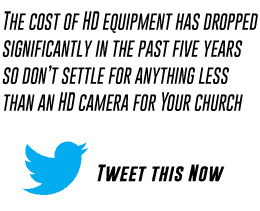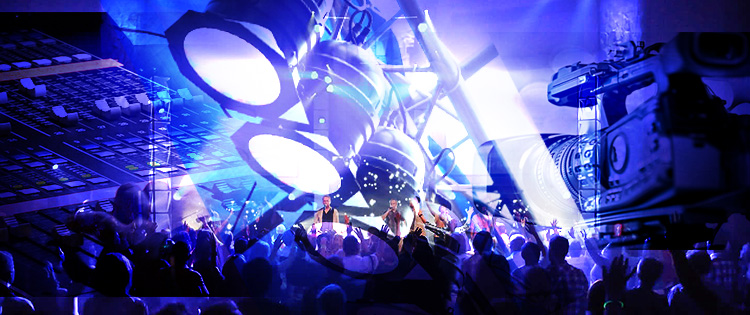Have you ever said to yourself, “Self, I wish I could launch a video ministry at church, but I have no idea where to start”? If the answer is yes then I’ve got some great news for you, I’ve compiled the top ten most important pieces of gear you need to start a video ministry at your church. This gear will translate to just about any facet of the video ministry. Whether you are thinking about live streaming, IMAG (image magnification….which means projecting a live video feed onto your screens), or if you just want to start a DVD library of your services; you’ll need most if not all of this gear.
10 Essential Pieces of Gear to Start a Video Ministry – Your Guide to Getting Video in Your Church
1. Cameras
This may seem obvious to some, but cameras are the most important piece of gear out of your entire video system. If there was a priority on which gear to spend the most money on, cameras would be number one. To give you an idea, roughly 40-50% of your project budget should go towards cameras. If you are forced to scale back your budget, consider a single camera system instead of the traditional three camera system. The cost of HD equipment has dropped significantly in the past five years so don’t settle for anything less than HD cameras, look at something like this JVC HD camcorder as a baseline.
2. Lights
More important than the intensity of the light is the consistency of the light. You can light well with inexpensive lights so long as they are hung and focused in the proper way. The tricky thing is most churches aren’t designed with video in mind. Go ahead and start our with a few of the basic Par 64 500 watt lights, but make sure that all your lamps are the same watt rating and beam rating. Lighting for video is mostly going to depend on the cameras that are used. As long as you promise to stay away from fluorescent lighting, you should be ok.
3. Mixer
The video switcher, or video mixer, is the device that allows an operator to seamlessly blend together several different video feeds into one feed. In an environment where more than one source (camera, computer, DVD player, etc) is used a mixer is the way that those sources are combined and blended. It was only a few years ago that HD video mixers started out in the $10,000 range and went up from there. Today, the Black Magic ATEM TV Studio is a full-on HD mixer that starts out at $1,000.
4. Communication
In any multi-camera environment communication with your camera operators is crucial. In many cases, the video switcher is located in a separate room, which can make communication impossible. Camera operators need to know what shots the director needs, when to move, when to zoom, and when they can use the restroom. Communication with these operators needs to be loud and clear, and preferably hard wired. Wireless communication systems are either ridiculously expensive, or they operate on the 802.11 band; which is overcrowded. The professional standard of Clear Com or Telex systems are nice, but still pretty expensive, I’ve found great success with the Data Video ITC-100.
5. DVD Recorder
DVD recorders work the exact same way as CD recorders, they can be recorded live on the fly then finalized for viewing on DVD players. Often times you can find these DVD recorders with built-in hard drives. This is my preferred way to record live, that way if your DVD disc is bad you still have your content on the internal hard drive, and it only adds about five more minutes to create the master disc. My personal all time favorite is this Magnavox DVD/HDD recorder, I’ve had this one with me for the past three years on the road and she still does a great job.
6. Audio Video Distribution Amplifier
An audio video distribution amplifier takes the audio and video feed coming in and splits across several outputs. These are usually designed so that the input connection is the same as the output connection; a common example is one composite audio/video in and four composite audio/video outs. There are pricier routers out there like the Black Magic Video Hub Router that handle patching with software, but most of us will be fine with something like this to get signal where it needs to go.
7. Analog to Digital Converter
The analog to digital converter is the piece of gear that converts the video signal so that it can be live streamed. Some of the higher end video mixers have a built-in USB or Firewire out for live streaming, but in most cases, you’ll need this separate piece of gear. The situation with live streaming is that though we capture in HD, we generally don’t broadcast in HD. Bandwidth restrictions on both the user end and the church end cause HD live streaming to be unrealistic. So for now, an SD converter will work just fine. I’ve used several of Grass Valley’s converters and am particularly fond of the ADVC-110.
8. Audio Compressor
Usually, the audio feed coming into the video mix is tapped off the board and is just a copy of the stereo output. In most cases, the audio level coming off the board is going to be inconsistent throughout your service. In an effort to save your viewers from having to adjust the volume on their TV every two minutes, add a compressor inline before your audio and video feeds mix. I use the ART PRO VLA II and I set the ratio at infinity to 1 with an attack as fast as it goes. This will ensure that there won’t be any surprise loud pops or spikes in your broadcast audio.
9. Scaler
The scaler is a device that converts video signals to fit different connections and aspect ratios. It’s especially important because this is the piece of gear that will upconvert an SD signal to work on an HD device, and visa versa. These devices are particularly helpful in IMAG environments where the live video feed is being projected onto screens. Many projectors aren’t equipped with the proper connections for IMAG and require the signal to be converted to something that can travel long distances without degrading quality. Kramer makes a huge line of scalers that upconvert and downconvert to just about anything, just make sure the model you get has all the right connections you need.
10. Duplicator
Honestly most duplicators on the market today are so similar to one another that the only defining facet to pay attention to is how many discs it can burn at once. If this is your first duplicator, get a minimum of a 1 to 10 burner and make sure that it can handle both CDs and DVD’s. Some duplicators come with software, or internal hard drives but I haven’t found those to be useful.
In today’s market, it’s not difficult to design a complete three camera video system that can handle IMAG, live streaming, and DVD recording for about $10,000. Once the budget is in place, give me a call and I’ll come show you how it all fits together!
What are some of your favorite pieces of gear that I left out?

